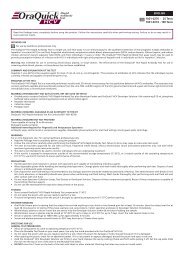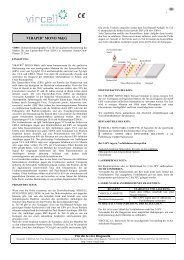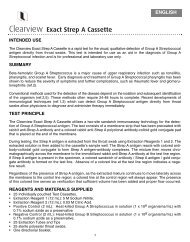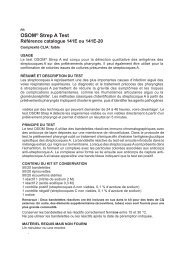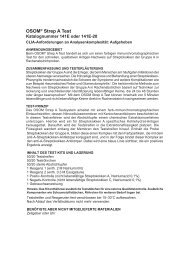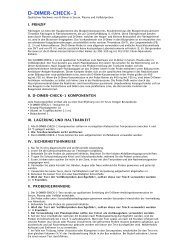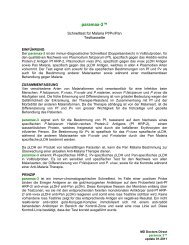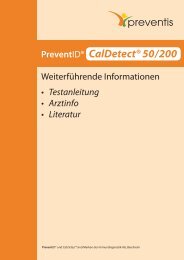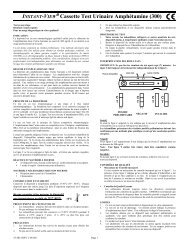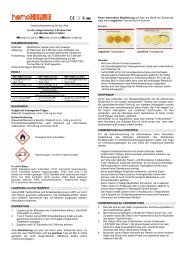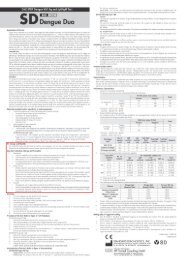INSTANT-VIEW® Methadone Urine Cassette Test - MD Doctors Direct
INSTANT-VIEW® Methadone Urine Cassette Test - MD Doctors Direct
INSTANT-VIEW® Methadone Urine Cassette Test - MD Doctors Direct
Create successful ePaper yourself
Turn your PDF publications into a flip-book with our unique Google optimized e-Paper software.
<strong>INSTANT</strong>-VIEW ® <strong>Methadone</strong> <strong>Urine</strong> <strong>Cassette</strong> <strong>Test</strong><br />
One Step Assay<br />
Rapid Visual Results<br />
For Qualitative In Vitro Diagnostic Use<br />
For Laboratory Use Only<br />
INTENDED USE<br />
This device is a qualitative immunoassay intended to provide qualitative<br />
screening results for methadone in human urine at a cutoff concentration of<br />
300ng/ml. It is for health care professional use only.<br />
This assay provides only a preliminary result. A more specific alternate<br />
chemical method must be used in order to obtain a confirmed analytical result.<br />
Gas Chromatography / Mass Spectrometry (GC/MS) is the preferred<br />
confirmatory method. Clinical consideration and professional judgment should<br />
be applied to any drug of abuse test result, particularly when preliminary<br />
positive results are obtained.<br />
SUMMARY AND EXPLANATION OF THE TEST<br />
<strong>Methadone</strong>, also called Dolophine, Methadose and Amidone, possesses many of<br />
the pharmacologic properties of morphine and is approximately equipotent as an<br />
analgesic when administered parenterally. Unlike morphine, however,<br />
methadone produces marked sedative effects with repeated administration as a<br />
result of drug accumulation. <strong>Methadone</strong> has been used as a major substitute for<br />
opiates, such as heroin, morphine, and codeine in drug maintenance treatment<br />
clinics. It is administered either orally or by intravenous or intra-muscular<br />
injection. The duration of effect of methadone is 12-24 hours. Its major urinary<br />
excretion products are methadone, EDDP (2-ethylidene-1, 5-dimethyl-3, 3-<br />
diphenylpyrrolidine), and E<strong>MD</strong>P (2-ethyl-5-methyl-3, 3-diphenylpyrrolidine).<br />
The percentage of methadone excreted unchanged in urine is 5-50%, much<br />
higher than EDDP and E<strong>MD</strong>P, of the dose in 24 hours. Large individual<br />
variations in the percentage of unchanged methadone excreted in urine have been<br />
observed due to urine pH, urine volume, dose and rate of metabolism, etc.<br />
<strong>Methadone</strong> has been found remaining in urine at levels higher than 1,000 ng/ml<br />
24 hours after overdose. Therefore the concentration of methadone in human<br />
urine has been used as a marker of methadone abuse.<br />
PRINCIPLE OF THE PROCEDURE<br />
This assay is a one-step lateral flow chromatographic immunoassay. The test<br />
strip includes 1) a burgundy-colored conjugate pad containing mouse antimethadone<br />
antibodies coupled to colloidal gold; and 2) nitrocellulose membrane<br />
containing a <strong>Test</strong> (T) line and a Control (C) line. The <strong>Test</strong> line is coated with<br />
methadone-BSA, and the Control line is coated with goat anti-rabbit IgG<br />
antibody.<br />
This test is a competitive binding immunoassay. The methadone in the urine<br />
specimen competes with the methadone–BSA antigen coated on the<br />
nitrocellulose membrane for the limited binding sites of the conjugated antimethadone<br />
antibodies.<br />
When an adequate amount of urine specimen is applied to the sample pad of the<br />
device, the urine specimen migrates by capillary action through the test strip. If<br />
the level of methadone in the urine specimen is below the cutoff (300 ng/ml), the<br />
<strong>Test</strong> line appears as a visible burgundy line. If the level of methadone in the<br />
urine specimen is at or above the cutoff, no <strong>Test</strong> line develops.<br />
The C line binds to the gold-conjugated rabbit IgG and forms a burgundy color<br />
line, regardless of the presence of methadone.<br />
REAGENTS AND MATERIALS SUPPLIED<br />
• 25 test devices, each sealed in a pouch with a dropper pipette.<br />
• 1 package insert (Instructions for Use).<br />
MATERIAL REQUIRED BUT NOT PROVIDED<br />
• Specimen collection containers<br />
• Timer<br />
STORAGE AND STABILITY<br />
Store the kit at room temperature 15-30°C (59-86°F). Each device may be used<br />
until the expiration date printed on the label if it remains sealed in its foil pouch.<br />
Do not freeze and/or expose the kit<br />
to temperatures over 30°C (86°F).<br />
15°C<br />
30°C<br />
SPECIMEN COLLECTION<br />
1. Each urine specimen must be collected in a clean container. Do not mix<br />
specimens.<br />
2. Specimens may be kept at 15-30°C (59-86°F) for up to 8 hours, at 2-8°C<br />
for up to 3 days and at -20°C or lower for long term storage.<br />
PRECAUTION<br />
1. The instructions must be followed exactly to obtain accurate results.<br />
2. Do not open the sealed pouch, unless ready to conduct the assay.<br />
3. Do not use expired devices.<br />
4. Dispose of all specimens and used assay materials as potentially<br />
biohazardous.<br />
ASSAY PROCEDURE<br />
1. Refrigerated specimens and other test materials, including devices, must<br />
be equilibrated to room temperature before testing.<br />
2. Remove the test device from its pouch and place it on a flat surface. Label<br />
the device with specimen identification.<br />
3. Holding the dropper vertically, add four drops of the specimen to the<br />
sample well.<br />
4. Read the test result between four (4) to seven (7) minutes after adding the<br />
specimen.<br />
INTERPRETATION OF RESULTS<br />
IMPORTANT: Do not read test results after seven (7) minutes. The T Line<br />
should always be interpreted independently of the C Line.<br />
Sample Well<br />
C<br />
T<br />
<strong>Test</strong> Line<br />
PRELIMINARY<br />
POSITIVE<br />
T<br />
Positive:<br />
If only the C line appears, the test indicates that the methadone level in the sample<br />
is at a cutoff of 300 ng/ml or higher.<br />
Samples with preliminary positive results should be confirmed with a more<br />
specific method before a positive conclusion is made.<br />
Negative:<br />
If both C line and T line appear, the test indicates that the methadone level is below<br />
300 ng/ml.<br />
Note: A faint T line should be considered negative.<br />
Invalid:<br />
If no C line develops in 5 minutes, repeat the assay with a new test device.<br />
C<br />
T<br />
(+) (-)<br />
C<br />
NEGATIVE<br />
Control Line<br />
QUALITY CONTROL<br />
• Built-in Control Features<br />
This test contains a built-in control feature, the C line. The presence of the<br />
C line indicates that an adequate sample volume was used and that the<br />
reagents migrated properly. If a C line does not form, the test is considered<br />
invalid. In this case, review the whole procedure and repeat the testing with<br />
a new device.<br />
• External Quality Control<br />
Users should always follow the appropriate federal, state, and local<br />
guidelines concerning the running of external quality controls. SAMHSA<br />
recommends that the concentration of drug(s) in positive and negative<br />
controls be approximately 25% above and below the cutoff concentration<br />
of the assay.<br />
C<br />
T<br />
C<br />
T<br />
INVALID<br />
33-3172 REV O 111611 Page 1
<strong>INSTANT</strong>-VIEW ® <strong>Methadone</strong> <strong>Urine</strong> <strong>Cassette</strong> <strong>Test</strong><br />
LIMITATIONS<br />
1. This test is for professional in vitro diagnostic use only.<br />
2. Results obtained by this device provide only a preliminary qualitative<br />
result. A more specific alternate chemical method must be used in order to<br />
obtain a confirmed result.<br />
3. This product is designed for testing human urine only.<br />
4. Adulterants such as bleach or other strong oxidizing agents may produce<br />
erroneous test results if present in the sample. When suspected, collect a<br />
fresh specimen and repeat the test with a new device.<br />
5. Samples in which bacterial contamination is suspected should not be used.<br />
These contaminants may interfere with the test and cause false results.<br />
EXPECTED VALUES<br />
This test is designed to detect methadone in human urine at a cutoff<br />
concentration of 300 ng/ml.<br />
PERFORMANCE CHARACTERISTICS<br />
1. Accuracy<br />
A study was performed at three different Physician’s Office Laboratories<br />
(POL) and a Reference Laboratory. One hundred (100) clinical samples<br />
were blind labeled and tested. Each sample was tested at each site, and<br />
compared with GC/MS results.<br />
The results agreed 100% with the GC/MS data of specimens at levels<br />
below 75% of the cutoff (negative) and above the cutoff (positive). Ten<br />
(10) discrepancies were observed on the specimens at level between 75%<br />
of the cutoff and the cutoff.<br />
The overall agreement was 97.5%.<br />
GC/MS<br />
(ng/ml)<br />
MTD <strong>Test</strong><br />
Positive Negative<br />
Total<br />
Agreement<br />
375)<br />
144 0 144 100%<br />
Total 190 210 400 97.5%<br />
2. Precision<br />
The precision was determined by replicate assays of four different levels of<br />
samples with three different production lots. The device was tested for<br />
five consecutive days five times each, for a total of 25 assays for each<br />
control.<br />
The results indicate 100% precision for the replicate within each lot and no<br />
appreciable interlot variation occured across the three (3) different lots of<br />
devices.<br />
3. Cross-Reactivity<br />
To determine the cross-reactivity of the structurally related compounds<br />
with the device, the following compounds were spiked into known drugfree<br />
urine pools and tested. Those compounds showed a positive response<br />
at the concentration indicated in the following table:<br />
Description<br />
Concentration (ng/ml)<br />
(-)-α-Methadol 800<br />
(-)-α-Acetylmethadol (LAAM) 1000<br />
4. Interference<br />
To determine the interference of structurally unrelated analytes, the<br />
following analytes were spiked into known drug-free urine pools, as well<br />
as the methadone positive (spiked with methadone to the level of 300<br />
ng/ml) urine pools and were tested. No significant interference with either<br />
negative or positive results was observed at the concentrations listed in the<br />
following table:<br />
Compounds listed in this table found not to interfere with the test<br />
results at the concentration of 1mg/ml:<br />
Acetaminophen<br />
Acetylsalicylic Acid<br />
Amikacin<br />
Amitriptyline<br />
Ampicillin<br />
Arterenal<br />
Aspirin<br />
Atropine<br />
Benzoic Acid<br />
Caffeine<br />
(+)-Chlorpheniramine<br />
Codeine<br />
Cortisone<br />
Dextromethorphan<br />
Ethanol<br />
Lidocaine<br />
Methanol<br />
Oxalic Acid<br />
Penicillin-G (Benzylpenicillin)<br />
Phenylpropanalamine<br />
Ranitidine<br />
Salicyclic Acid<br />
Thioridazine<br />
Trifluoperazine<br />
Biological Analytes<br />
Concentration<br />
Albumin<br />
2 mg/ml<br />
Bilirubin<br />
1 mg/ml<br />
Creatine<br />
1 mg/ml<br />
Hemoglobin<br />
1 mg/ml<br />
Glucose<br />
2 mg/ml<br />
PH 5.0 – 9.0<br />
Vitamin C (L-Ascorbic Acid)<br />
1 mg/ml<br />
Uric Acid<br />
1 mg/ml<br />
There is a possibility that other substances and/or factors not listed may<br />
interfere with the test and cause false results.<br />
REFERENCES<br />
• FDA Guidance for Labeling <strong>Urine</strong> Drugs of Abuse Screening <strong>Test</strong>ing, Kshit Mohan,<br />
7/21/87.<br />
• <strong>Urine</strong> <strong>Test</strong>ing for Drugs of Abuse. National Institute on Drug Abuse (NIDA): Research<br />
Monograph 73, 1986.<br />
• Baselt, R.C. Disposition of Toxic Drugs and Chemicals in Man, 4th ED., Biomedical<br />
Publ., Davis, CA; p472-474, 1995.<br />
• Department of Health and Human Services, Mandatory Guidelines for Federal<br />
Workplace Drug <strong>Test</strong>ing Programs, Fed. Register. p.53 (69): 11970 (1988).<br />
• Wilson, John, Abused Drugs II, a Laboratory Pocket Guide., AACC Press.<br />
Washington, DC; 1994.<br />
EC REP<br />
Temperature limitation<br />
Batch/Lot code<br />
Manufacturer<br />
Contains sufficient for < n ><br />
tests<br />
Do not reuse<br />
Caution, consult accompanying<br />
documents<br />
Alfa Scientific Designs Inc.<br />
13200 Gregg St.<br />
Poway, CA 92064 – USA<br />
Made in USA<br />
REF 3172<br />
Obelis s.a<br />
Boulevard Général Wahis 53<br />
1030 Brussels, BELGIUM<br />
Tel.: +32.2.732.59.54<br />
Fax: +32.2.732.60.03<br />
Email: mail@obelis.net<br />
Use by<br />
YYYY-MM<br />
In vitro diagnostic<br />
medical device<br />
Catalog number<br />
Consult instructions for<br />
use<br />
CE Mark<br />
33-3172 REV O 111611 Page 2




